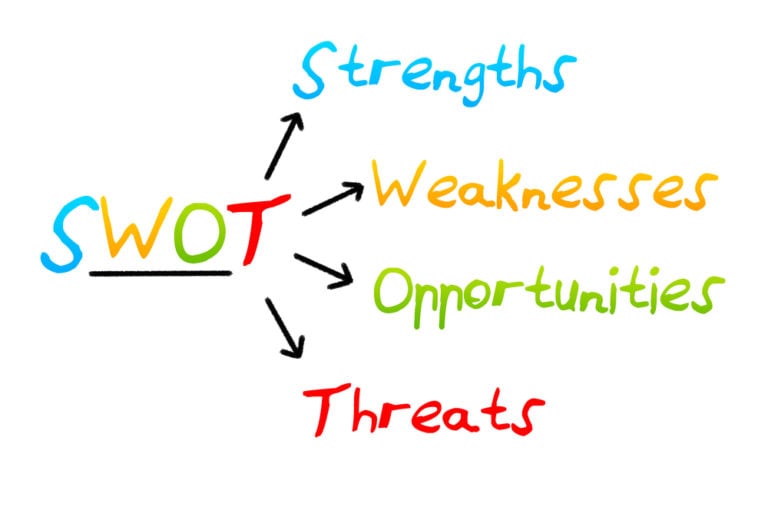Marketing strategy is an action plan that helps an organization focus its resources on the best opportunities to increase sales and achieve sustainable competitive advantage.
It defines marketing goals and explains how the organization intends to achieve those goals.
Here are the key elements that marketing strategies should contain:
- Understanding the Market: Your marketing strategy should begin with a deep understanding of the market in which you operate. This includes analyzing competitors, customers, and market trends.
- Define your target audience: You need to understand who your marketing efforts are aimed at. Defining your target audience accurately will allow you to target your offers and messages to the people who are most likely to be interested in your product or service.
- Defining Marketing Objectives: Objectives should be consistent with the overall business objectives of the company. These may include increasing brand awareness, increasing sales, attracting new customers or retaining existing ones.
- Positioning your product or service’s marketing strategy: You need to decide how you want your product or service to be perceived in the marketplace compared to your competitors.
- Choice of marketing channels: There are many marketing channels at your disposal, such as email marketing, social media, content marketing, SEO, offline marketing, etc. The choice depends on your target audience and the type of product or service.
- Budget and Resources: A marketing strategy should take into account available resources such as budget, time and skills.
- Action Plan: The action plan should state what, when and how will be done to achieve the marketing objectives.
- Monitoring and measuring your marketing strategy: You need to determine how you will monitor and measure the effectiveness of your marketing strategy. This may include tracking KPIs, analyzing sales performance, or using analytics tools.
Understanding the Market

When studying competitors, companies need to understand exactly who their competitors are, what their strategy is, what products they offer, and how consumers perceive them. Further, understanding the consumer requires accurate profiling and market segmentation in order to understand their needs, behaviors, and motivations.
Companies must collect and analyze demographic, behavioral and psychographic data. Finally, tracking market trends is necessary to understand the general directions in which the market is moving. These may be technological, social, economic or political trends.
A deep understanding of these three dimensions allows companies to effectively position their products or services, shape marketing messages, and create value that meets customer needs and differentiates them from competitors.
Tools to understand the market
Analyzing competitors, customers and market trends is a key part of creating an effective marketing strategy. There are many tools and methodologies that can help companies conduct this analysis:
- SWOT analysis (Strengths, Weaknesses, Opportunities, Threats): This is a popular strategic tool that helps companies understand their internal strengths and weaknesses, as well as external opportunities and threats in the market.
- Google Trends: This is a free tool from Google that allows you to track and analyze search trends for specific keywords. This is useful for understanding what topics are popular among consumers and how these trends change over time.
- Social media analysis tools (eg Hootsuite, Sprout Social, BuzzSumo): These tools help companies track what people are saying about their brand, product or industry on social media. They can also help identify influencers in a particular industry.
- Competitor analysis tools (e.g. SEMRush, Ahrefs, SimilarWeb): These tools allow companies to analyze their competitors’ SEO and social media marketing strategies.
- Market research and surveys (eg SurveyMonkey, Google Surveys): These tools allow you to collect direct customer and potential customer feedback. These may include questions about product preferences, shopping habits, demographics, and other important information.
- Google Analytics: This is an essential tool for monitoring and analyzing website traffic. It helps you understand where users come from, what pages they view, how long they stay on the site, and more.
- Customer data analysis tools (e.g. CRMs like Salesforce, HubSpot): These systems help companies collect, organize and analyze information about their customers to better understand their needs and preferences.
Specifying the target group
Identifying the target group, like understanding the market, is a key element of a marketing strategy as it helps a company understand who it is targeting with its marketing efforts.

A well-defined target group allows a company to effectively tailor its marketing messages, product offerings, and even distribution channels to meet the specific needs and expectations of those people. The precise definition of the target audience allows the company to direct its marketing efforts and resources where they will be most effective, which increases the chances of success in the market.
Target groups and marketing personas
A marketing persona may include information such as age, gender, occupation, educational level, location, lifestyle, interests, priorities, values, concerns, goals, and preferred channels of communication.
Marketing personas are central to marketing strategy as they help organizations better understand and meet the needs of their customers. With their help, companies can tailor their products, services and marketing messages to the specific needs and expectations of different consumer segments. In addition, marketing personas can help companies identify the best channels and tactics to reach their target audience.
For example, if a company’s marketing persona is a “working mom”, the company can focus on providing products and services that facilitate the balance between home and work responsibilities and communicate with this group through channels that are most convenient and effective for them, such as social media or Email.
Creating and using marketing personas is not only an effective way to increase the impact of your marketing activities, but also to build stronger, more personalized relationships with your customers.
Marketing Goals

Marketing objectives can cover various aspects, depending on the specific company and its needs. Some of the most common marketing goals include:
- Increase brand awareness: A company may want more people to know or have positive associations with its brand.
- Increasing sales: A company may seek to increase the number of products or services sold, which can be measured in terms of units sold, cost of sales, or profit.
- Acquiring new customers: A company may want to increase the number of customers who use its products or services.
- Existing customer retention: A company may seek to increase customer loyalty and the frequency of use of its products or services.
- Improve customer satisfaction: A company may seek to improve customer satisfaction, which can be measured through customer satisfaction surveys.
- Growing market share: A company may want to increase its market share relative to its competitors.
These goals should be monitored and measured regularly, and the marketing strategy should be adjusted based on progress towards these goals. Remember that marketing goals should always support the overall strategic goals of the company.
Philip Kotler’s marketing goals
Philip Kotler identifies four general marketing goals:
- Customer Acquisition: With minimal customer acquisition costs, marketing activities should be focused on attracting new customers. This is important for the further growth and expansion of the company.
- Retention of existing customers: Kotler stresses the importance of maintaining and deepening relationships with existing customers. In today’s competitive business environment, keeping a customer is often harder than getting one.
- Create customer satisfaction: Customer satisfaction is a key goal that leads to loyalty and repeat purchases. It is directly related to the quality of products or services and the level of customer service.
- Creating Brand Value: Building a strong brand is one of the main goals of marketing. A brand that offers exceptional value and is well received by consumers can give a company a competitive edge.
All these goals should be clearly defined, measurable, realistic and correlated with the overall strategic goals of the company.
Product or service positioning

It is a key part of your marketing strategy and helps you determine what makes your offering different and unique from other products or services on the market. Positioning affects everything from the shape of the product, its price and marketing communications.
Positioning begins with the definition of a unique selling proposition (“USP” – Unique Selling Proposition) of your product or service. USPs are the characteristics that make your offering stand out from the competition – it could be unique product features, exceptional service, an attractive price, or any other value you provide to your customers.
Once you have determined your USP, the next step is to get it across to your target audience. For this, various marketing techniques can be used, such as advertising, public relations, social media marketing, content marketing, and others.
Remember that positioning is not a one-time task – you need to constantly monitor the market, competitors and your target audience, and then adjust your positioning as necessary. The goal is to keep your offering attractive and relevant to consumers in a rapidly changing market environment.
Choosing Marketing Channels

Email marketing can be effective in building relationships with customers and keeping their interest through regular communications. Social media, on the other hand, can be a powerful tool to build brand awareness and reach your target audience.
Content marketing and SEO are key to driving and maintaining website traffic. On the other hand, offline marketing such as TV, radio and print ads can be effective in reaching a wide audience.
Each of these channels has its own strengths and weaknesses, so it is important to carefully consider which one will be most effective in your particular case.
Budget and Resources
Choosing a budget and resources is a key part of planning your marketing strategy. Proper management of them is necessary to achieve marketing goals. Here are some principles that can help in this process:
- Understanding your marketing goals: First you need to clearly define your marketing goals. This will help you determine what resources will be required to achieve these goals.
- Realistic planning: All goals and strategies must be realistic and achievable within available resources. If the plan is too ambitious, it can lead to resource overload and failure to achieve the intended goals.
- Understanding ROI (return on investment): Different marketing efforts can generate different returns on investment. By analyzing previous marketing activities, you can understand which ones are producing the best results and deserve a larger share of your budget.
- Flexibility: Markets are dynamic and things can change quickly. Therefore, your budget and resources must be flexible so that you can adapt to new circumstances.
- Split budget: It’s a good idea to split your budget across different marketing channels so you don’t depend solely on a single traffic source or promotion strategy.
- Monitoring and Control: Regularly checking that the budget is being spent as planned and delivering the expected results is key. If something is not working as it should, you should be prepared to change the plan and redirect resources to where they will be most effective.
Action plan
An example action plan in a marketing strategy might look like this:
Objectives: Increase brand awareness by 25% over the next 6 months.
Understanding the target audience: Our target audience is young professionals aged 25-35 who are active on social media, especially Instagram and LinkedIn.
Competitor Analysis: We are constantly analyzing our main competitors in the market, monitoring their marketing activities and responding to any changes in their strategies.

Product/Service Positioning: Our product is of higher quality and has additional features not found in our competitors’ products. We emphasize this in our marketing communications.
Choosing Marketing Channels: We focus on social media (Instagram, LinkedIn), content marketing on our blog and email marketing.
Action plan:
- Develop an Instagram campaign, including regular posts promoting our product and features, contests for our followers, and collaborations with influencers.
- Create valuable content on our blog to help build credibility in our industry.
- Regular email newsletter with information about new products, promotions and valuable content from our blog.
Budget: Our marketing budget for the next 6 months is £50,000 which we will distribute across various marketing channels.
Measure and control: We will regularly monitor the results of our marketing activities using the analytics tools available on each channel to understand which activities are producing the best results and make adjustments as necessary.
Monitoring and measurement
The following are some key aspects to look out for when monitoring the effectiveness of a marketing strategy:
- KPIs (Key Performance Indicators): These are measurable numbers that show how effectively a company is achieving key business goals. In the context of marketing, this can be metrics such as the number of new customers, conversion rate, customer acquisition cost (CAC), customer lifetime value (CLV), etc.
- Return on investment (ROI): This is a measure of the effectiveness of an investment. It shows how much profit each unit of the invested currency brings. In the case of marketing, this may mean comparing the cost of a marketing campaign to the profit it generated.
- Engagement: In the context of digital marketing, engagement is how users interact with your brand online. This may include things like clicks, shares, comments, likes, and other activities on your website or social media.
- Website Traffic: Analyze website traffic, traffic sources, page views, time spent on site, churn rate, and more. can give many clues about the effectiveness of various marketing efforts.
- Competitor Analysis: Monitoring the performance of your competitors and comparing their performance to your own can provide valuable insights to help you improve your strategy.
- Customer Feedback: Customer feedback is an invaluable source of information about what works and what can be improved. This can be tracked through reviews, surveys, or direct customer comments.
















